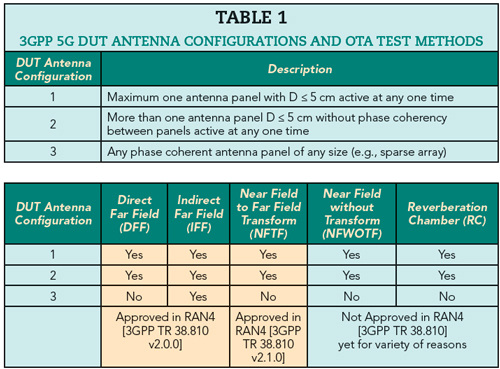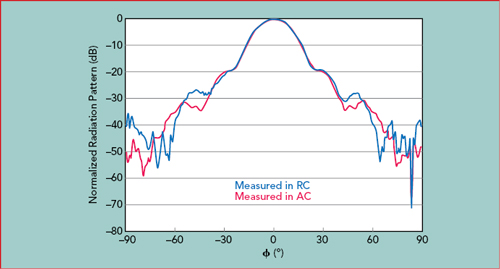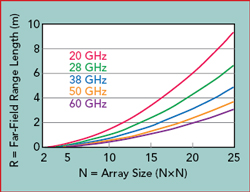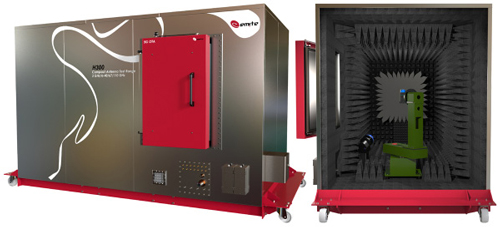The path towards a realistic and cost-effective 5G over-the-air (OTA) testing scenario is not clear yet. With a tremendous pressure on 5G standards development, network deployments and device manufacturing, the realistic answers that a 5G OTA test system should provide are far from being obtained to date. This article identifies some of the challenges ahead with possible solutions.
New Radio (NR) is eagerly expected as the total solution for current wireless communications demands aiming to provide fast throughput and low latency, with a significant improvement in user’s quality of service (QoS) and quality of experience (QoE). The primary concern is the need to satisfy the exponential rise in user and traffic capacity in mobile broadband communications. Global mobile traffic will experience a growth from 7,201 petabytes per month in 2016 to around 48,270 petabytes per month in 2021, an astonishing 670 percent growth.1 NR is also expected to handle an enormous number of devices connected to IP networks, some 3x as high as the global population in 2021, raising up from 2.3 networked devices per capita in 2016 to 3.5 by 2021. To add complexity, a perceived availability of 99.999 percent and ultra-reliability are also envisioned as key features of 5G.
In the race towards satisfying the expected growth, connectivity, availability and reliability, 3GPP and CTIA have emerged as the standardization bodies that will enable adequate OTA testing of the new technologies prior to massive deployment. With the experience of 4G OTA testing standardization history in mind, there are more questions about the capabilities of consensus-driven OTA testing standardization and how it works to solve the real challenges of 5G deployment and operation. With new engineering concepts in 5G like MIMO, beamforming and the generalized use of mmWave frequencies, 5G OTA testing is clearly the challenge of the decade for wireless communications and a key milestone for 5G deployment and operational success.

5G OTA TEST METHODS
Three different 5G device under test (DUT) antenna configurations and several 5G OTA test methods are being discussed within 3GPP TR 38.810, summarized in Table 1. The Reverberation Chamber (RC) method can be very useful for isotropic Key Performance Indicators (KPI), particularly total radiated sensitivity (TIS) or spurious emissions, and recent progress has added the capability of directional measurements by means of either time-reversal or Doppler-discrimination effects,2 as shown in Figure 1. Non-conventional uses of RCs for 5G OTA measurements are also being explored, in particular for devices designed to function in directional-channel environments3 and for real-time OTA testing of throughput and latency. RC-based methods have some positive aspects for 5G Non-Standalone (NSA) and Standalone (SA) OTA testing, like considerably-reduced setup cost compared to other solutions for the complex multicarrier requirements. While spatial information may be partially lost in these rich multipath systems, an average 3D isotropic emulation of delay and final throughput performance, which is after all what the user perceives in a reasonable time slot, may very well serve the purpose. Yet, little progress has been made for 5G OTA using isotropic 5G channel model emulation using RCs and with RCs lack of strong support at 3GPP, it is not yet a 5G-standardized test method.

Figure 1 AUT H-plane radiation pattern measured in RC and in AC (reproduced from Reference 2 with permission).
Extending the multiprobe anechoic (MPAC) approach to 5G implies the use of 3D channel models and mmWave operation, which makes it impractical due to the increase in complexity and the fact that too many probes would be needed, with their associated channel emulator ports, and the effect on the already-reduced quiet zone will be large. Although some simplified sectorized MPAC variations have been proposed, the additional need to operate in the far-field makes the use of MPAC for 5G OTA limited, at least at mmWave frequencies.
The incorporation of the Radiated Two-Stage (RTS) method into standardized 5G OTA testing is benefiting from an apparent harmonization to the MPAC method using seven 4G LTE FDD devices in single 2x2 single-carrier MIMO OTA mode, but the “Wireless Cable” is not transparent with respect to the DUT antenna characteristics, as these must be measured beforehand for the method to be applicable. In addition, the RTS method cannot yet support the user equipment (UE) beamlock test function (UBF) for 5G UEs which is clearly a limiting factor for standardized OTA testing. On the other hand, the electrical size of DUT is only limited by the size of the test chamber.

Figure 2 Far-field range for an NxN array of λ/2 spaced elements.
The Indirect Far Field (IFF) Compact Antenna Test Range (CATR) method can create a plane-wave field in much less space than a Direct Far Field (DFF) method by means of a reflector, and it seems ideal for 5G mmWave OTA testing, but it has difficulties providing different frequency ranges. With the options on the table, CTIA operators have recently considered the IFF method as essential for consideration during development of the CTIA 5G NSA mmWave OTA Test Plan v1.0,4 due for release in 2Q 2019.
The Near Field to Far Field (NFTF) method relies on using a mathematical transformation to determine the KPIs in the far field from a near-field pattern scan. The NFTF method shows deficits with respect to testing during real-time operation of the device. Initially, Equivalent Isotropic Radiated Power (EIRP) and Total Radiated Power (TRP) have been reported to be measured by NFTF test systems.
The Direct Far Field (DFF) method requires Fraunhofer far-field distances and for mmWave frequencies, it is not practicable due to the space and cost requirements and the large link budget. Figure 2 illustrates how the far-field range for an NxN array of half-wavelength spaced elements increases dramatically as the size of the array increases. The hybridization of DFF for use at 5G sub-6 GHz frequencies, however, it may be quite useful since other methods present drawbacks at low frequencies.
It is clear that there is no single OTA method today capable of providing answers to all the challenges of 5G testing. Several companies and institutions have called for the development of new or hybridized test methods that can provide the required answers to the numerous 5G OTA challenges presented. One good option is the recently-released CATR+DFF+SNF 5G OTA Test System shown in Figure 3. A specific and optimized reflector design covers both the mmWave region (Frequency Range 2 or FR2) and part of the sub-6 GHz region (Frequency Range 1 or FR1), and a hybrid DFF/SNF tower completes the picture to provide full-range and simultaneous FR1+FR2 OTA testing.

Figure 3 H300 CATR+DFF+SNF 5G OTA Test System by EMITE.
